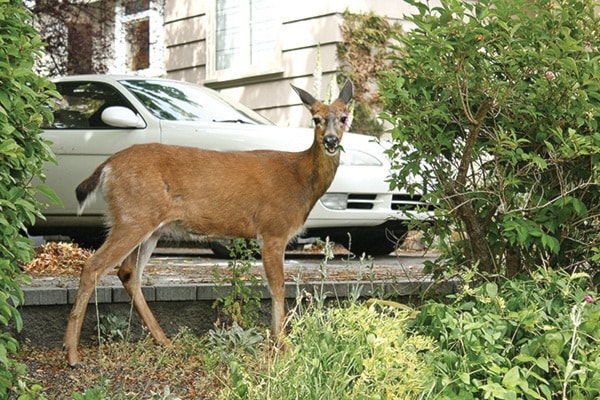Now that the results of a deer survey amongst Esquimalt residents has been tallied, councillors want to push ahead with a public education campaign and possible deer count.
In the fall, 11,000 surveys consisting of 24 questions (conducted by Brian Nyberg of Nyberg Wildland Consulting), were distributed to one in every three residences with an outside entrance and a yard in six neighbourhoods. Of those surveys, 46 per cent were returned.
On Monday, Nyberg presented the findings to members of Esquimalt council, noting one of the most striking things was that 84 per cent of people reported seeing deer in their yard or signs of deer. Amongst the neighbourhoods surveyed, Parklands had the highest number of sightings (100 per cent), followed by Esquimalt Village (90 per cent) and Rockheights (86 per cent). West Bay reported the fewest sightings at 67 per cent.
More than a quarter of respondents reported seeing deer more than 16 days per month and half felt that deer sightings had increased on their properties in the last year. Just under half also reported that deer had significantly damaged their plants.
When asked whether residents enjoy seeing deer on their property the majority said no. More than half also said they would be willing to contribute increased annual taxes to fund a program for deer management.
Nyberg said it would be wise for the township to get a better handle on how many deer are actually out there before further steps are taken. The Department of National Defence will be doing a deer count in the spring of 2017. He also recommended expanding public education on how to “target harden” yards for deer and coordinate a plan with surrounding jurisdictions.
“Esquimalt is not an island. So no matter what you do here, you can expect that deer would come back in from surrounding areas,” he said. “It's not going to be easy, no matter what you decide to do.”
The Urban Wildlife Stewardship Society (UWSS) has been working with the township to figure out what exactly the concerns are pertaining to deer and how they should be addressed. Last October, the society proposed a pilot project that would trap female deer, then inject them with a contraceptive vaccine that's proven effective and can be used to control populations.
The idea was also pitched to Oak Bay since they faced major critisism in February 2015 over the cull of 11 deer as part of a $250,000 Capital Regional District (CRD) pilot program for deer management. Members of the society wanted to offer alternatives other than killing the animals.
UWSS president Kristy Kilpatrick hopes to radio collar some of the deer so researchers can get a sense of how much they are traveling. Oak Bay, however, has yet to conduct a comprehensive survey like the one done in Esquimalt.
“One of the vital pieces of us doing the immuno-contraception is there needs to be a baseline of the number of deer. There's no point in doing deer reduction if you don't know how many deer you have in the first place,” said Kilpatrick. “We're cautiously optimistic there will be some funding to do a trial in Oak Bay and we are in touch with the province and working with the province to make sure that happens sooner than later.”
Esquimalt councillors agreed not taking further action is simply not an option and directed staff to prepare a report on the various options for a deer count.
Coun. Tim Morrison has been invited to many households to tour gardens damaged by deer. Many residents, he noted, have already given up the fight.
“It's been pretty clear there's definitely a deer problem in Esquimalt. It cannot be ignored,” said Morrison, noting a conversation about a cull would divide the community.
“People who are frustrated about the deer are not necessarily in favour of a cull....I would venture to guess that we would have almost unanimous support around contraception strategies as opposed to a cull.”
Any effort regarding managing or controlling deer population requires authority from the province by way of a permit. Through its provincial Urban Deer Cost-share Program, the government is providing up to $20,000 per eligible community for projects that focus on deer culls and research into population control methods such as relocation and immuno-contraception.
Earlier this month, grants were given to Invermere, Grand Forks, Elkford and Cranbrook to cull deer in the community. A fifth application from Oak Bay is still under consideration since it involves the use of immuno-contraceptive drugs designed to prevent deer from reproducing — something the province calls a “complex undertaking” that requires further research into the availability of drugs and careful planning to ensure they are delivered in a humane and effective way.
editor@vicnews.com
